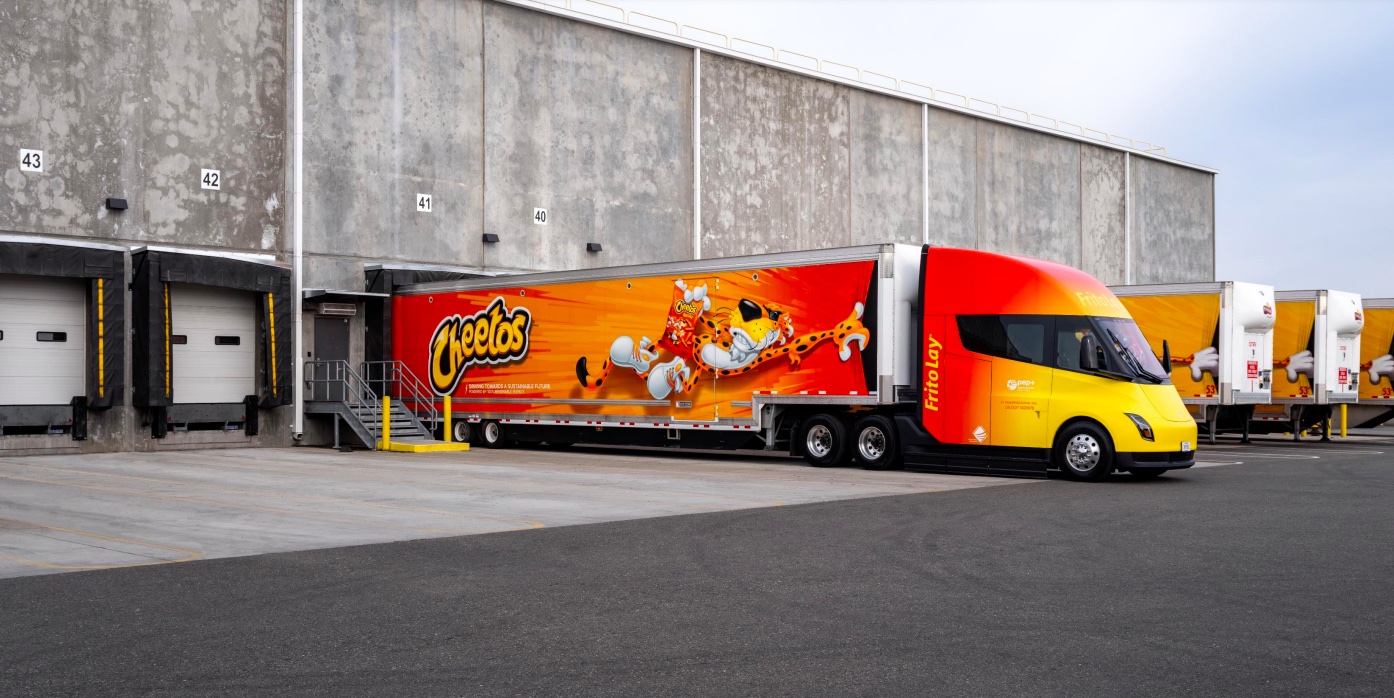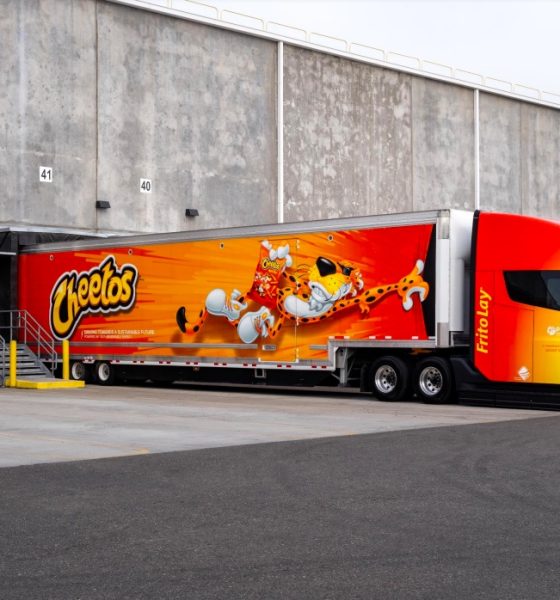

News
Tesla Semi production specs: powertrain, battery, Megacharger output, and more
The Tesla Semi has already been delivered to its first customers, but the actual production specs of the vehicle remain largely unknown or unconfirmed at best. Fortunately, a recent trip to PepsiCo’s Frito Lay facility in Modesto, Caifornia has provided some details that otherwise reveal the Tesla Semi production specs.
When Tesla held the first deliveries of the Semi, CEO Elon Musk highlighted that sustainable long-haulers are needed because in the transportation sector, semi trucks comprise about just 1% of vehicles on the road but they account for 20% of the emissions. Vehicles like the Tesla Semi are then designed to challenge this status quo.
Automotive publication MotorTrend was able to visit PepsiCo’s Modesto Frito Lay facility to check out the company’s first Tesla Semi units. As noted by the publication, the Modesto facility is a perfect fit for the Semi as the site already uses other green vehicles like BYD 8Y yard tractors, Peterbilt 220EV electric box trucks, and natural-gas-powered Volvo VNL trucks. The Tesla Semi fleet is used for out-and-back trips across the region.
The publication was able to gather some details about the Class 8 all-electric truck from its drivers and Tesla representatives who were at the location during the visit. Following are some key specs of the Tesla Semi.
Powertrain
The Tesla Semi features a modified Plaid tri-motor powertrain that’s spun backward. The Model S’ front motor drives the Semi’s rear axle and acts as the vehicle’s high-efficiency “highway drive unit.” The Model S Plaid’s dual rear motors, on the other hand, are installed on the rear axle. With this in mind, MotorTrend estimated that the Tesla Semi likely matches the Model S and Model X Plaid’s 1,020 horsepower and 1,050 pounds-feet of torque.
This estimate makes sense considering that a Tesla representative reportedly noted that the Tesla Semi makes “three times the power of an average diesel semi.” The US’ best-selling semi is the Freightliner Cascadia, whose base model features 350 horsepower. Three times the base Cascadia’s horsepower certainly aligns with the estimate that the Semi has about 1,020 horsepower. On a side note, the Tesla Semi production version does not have a frunk, unlike the vehicle’s prototype units.
Battery
Drivers of the Tesla Semi reportedly noted that the all-electric Class 8 truck is fitted with a 1,000 kWh battery pack. Tesla lists the Semi’s range as 500 miles per charge, and Elon Musk has also highlighted that the vehicle would consume only 2 kW per mile traveled.
If these estimates prove accurate, then the Semi’s 300-mile variant would likely have a battery pack that’s around 600 kWh. That’s still a lot of batteries, so Tesla would have to ensure that its production is optimized to ensure that the Semi is profitable.
Megacharger Output
The Tesla Semi features a charging port that’s different from all the vehicles that the company has released so far. The motoring publication noted that the Tesla Semi’s Megachargers installed on the Modesto facility could provide around 750 kW of power, or about three times the output of the company’s Supercharger V3 network.
The cables for the Tesla Semi’s Megachargers are thick, though they are reportedly easy to manage compared to some DC fast charging networks in the market. Charging the Semi from almost empty to 70% typically takes about 30 minutes. A full charge all the way to 100% reportedly takes around 90 minutes.
Physical Controls
While the Tesla Semi’s controls are mostly centered on its two infotainment systems, the vehicle also sports several physical buttons. Among these are the parking brake, trailer-brake air supply, and the vehicle’s hazards. Other physical controls include stalks similar to those found in the Tesla Model 3 and Model Y, though some buttons on the steering wheel resemble those in the new Model S and Model X.
Interior Space
The cabin of the Tesla Semi is cavernous, similar to the company’s other vehicles. MotorTrend noted that there’s enough space to enable a six-foot person to walk around and stretch in the Tesla Semi’s 3×7 foot cabin. So far, PepsiCo’s drivers seem to like the Semi, with some telling the motoring publication that the all-electric truck was very comfortable and “drove like a car.”
Other Details
The use of the Tesla Semi’s dual infotainment systems is quite interesting. The right display functions as the Tesla Semi’s main infotainment unit, while the left display exclusively shows pertinent information about the truck, such as its tire pressure. The windows in the Semi’s cabin also open when needed, though they do not roll down. Some space in the cabin also seem to be reserved for customers who wish to order the Tesla Semi with a sleeper cabin. Images taken of the Semi’s displays also confirm that the vehicle is equipped with Tesla’s Full Self-Driving computer.
Don’t hesitate to contact us with news tips. Just send a message to simon@teslarati.com to give us a heads up.

News
Tesla FSD fleet is nearing 7 billion total miles, including 2.5 billion city miles
As can be seen on Tesla’s official FSD webpage, vehicles equipped with the system have now navigated over 6.99 billion miles.

Tesla’s Full Self-Driving (Supervised) fleet is closing in on almost 7 billion total miles driven, as per data posted by the company on its official FSD webpage.
These figures hint at the massive scale of data fueling Tesla’s rapid FSD improvements, which have been quite notable as of late.
FSD mileage milestones
As can be seen on Tesla’s official FSD webpage, vehicles equipped with the system have now navigated over 6.99 billion miles. Tesla owner and avid FSD tester Whole Mars Catalog also shared a screenshot indicating that from the nearly 7 billion miles traveled by the FSD fleet, more than 2.5 billion miles were driven inside cities.
City miles are particularly valuable for complex urban scenarios like unprotected turns, pedestrian interactions, and traffic lights. This is also the difference-maker for FSD, as only complex solutions, such as Waymo’s self-driving taxis, operate similarly on inner-city streets. And even then, incidents such as the San Francisco blackouts have proven challenging for sensor-rich vehicles like Waymos.
Tesla’s data edge
Tesla has a number of advantages in the autonomous vehicle sector, one of which is the size of its fleet and the number of vehicles training FSD on real-world roads. Tesla’s nearly 7 billion FSD miles then allow the company to roll out updates that make its vehicles behave like they are being driven by experienced drivers, even if they are operating on their own.
So notable are Tesla’s improvements to FSD that NVIDIA Director of Robotics Jim Fan, after experiencing FSD v14, noted that the system is the first AI that passes what he described as a “Physical Turing Test.”
“Despite knowing exactly how robot learning works, I still find it magical watching the steering wheel turn by itself. First it feels surreal, next it becomes routine. Then, like the smartphone, taking it away actively hurts. This is how humanity gets rewired and glued to god-like technologies,” Fan wrote in a post on X.
News
Tesla starts showing how FSD will change lives in Europe
Local officials tested the system on narrow country roads and were impressed by FSD’s smooth, human-like driving, with some calling the service a game-changer for everyday life in areas that are far from urban centers.

Tesla has launched Europe’s first public shuttle service using Full Self-Driving (Supervised) in the rural Eifelkreis Bitburg-Prüm region of Germany, demonstrating how the technology can restore independence and mobility for people who struggle with limited transport options.
Local officials tested the system on narrow country roads and were impressed by FSD’s smooth, human-like driving, with some calling the service a game-changer for everyday life in areas that are far from urban centers.
Officials see real impact on rural residents
Arzfeld Mayor Johannes Kuhl and District Administrator Andreas Kruppert personally tested the Tesla shuttle service. This allowed them to see just how well FSD navigated winding lanes and rural roads confidently. Kruppert said, “Autonomous driving sounds like science fiction to many, but we simply see here that it works totally well in rural regions too.” Kuhl, for his part, also noted that FSD “feels like a very experienced driver.”
The pilot complements the area’s “Citizen Bus” program, which provides on-demand rides for elderly residents who can no longer drive themselves. Tesla Europe shared a video of a demonstration of the service, highlighting how FSD gives people their freedom back, even in places where public transport is not as prevalent.
What the Ministry for Economic Affairs and Transport says
Rhineland-Palatinate’s Minister Daniela Schmitt supported the project, praising the collaboration that made this “first of its kind in Europe” possible. As per the ministry, the rural rollout for the service shows FSD’s potential beyond major cities, and it delivers tangible benefits like grocery runs, doctor visits, and social connections for isolated residents.
“Reliable and flexible mobility is especially vital in rural areas. With the launch of a shuttle service using self-driving vehicles (FSD supervised) by Tesla in the Eifelkreis Bitburg-Prüm, an innovative pilot project is now getting underway that complements local community bus services. It is the first project of its kind in Europe.
“The result is a real gain for rural mobility: greater accessibility, more flexibility and tangible benefits for everyday life. A strong signal for innovation, cooperation and future-oriented mobility beyond urban centers,” the ministry wrote in a LinkedIn post.
News
Tesla China quietly posts Robotaxi-related job listing
Tesla China is currently seeking a Low Voltage Electrical Engineer to work on circuit board design for the company’s autonomous vehicles.

Tesla has posted a new job listing in Shanghai explicitly tied to its Robotaxi program, fueling speculation that the company is preparing to launch its dedicated autonomous ride-hailing service in China.
As noted in the listing, Tesla China is currently seeking a Low Voltage Electrical Engineer to work on circuit board design for the company’s autonomous vehicles.
Robotaxi-specific role
The listing, which was shared on social media platform X by industry watcher @tslaming, suggested that Tesla China is looking to fill the role urgently. The job listing itself specifically mentions that the person hired for the role will be working on the Low Voltage Hardware team, which would design the circuit boards that would serve as the nervous system of the Robotaxi.
Key tasks for the role, as indicated in the job listing, include collaboration with PCB layout, firmware, mechanical, program management, and validation teams, among other responsibilities. The role is based in Shanghai.
China Robotaxi launch
China represents a massive potential market for robotaxis, with its dense urban centers and supportive policies in select cities. Tesla has limited permission to roll out FSD in the country, though despite this, its vehicles have been hailed as among the best in the market when it comes to autonomous features. So far, at least, it appears that China supports Tesla’s FSD and Robotaxi rollout.
This was hinted at in November, when Tesla brought the Cybercab to the 8th China International Import Expo (CIIE) in Shanghai, marking the first time that the autonomous two-seater was brought to the Asia-Pacific region. The vehicle, despite not having a release date in China, received a significant amount of interest among the event’s attendees.








